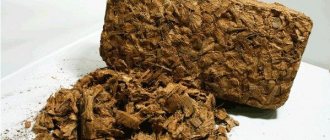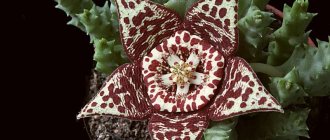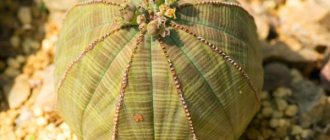Euphorbia is a rare houseplant that requires so little attention and care. His favorite place indoors is partial shade. Under natural conditions, it is able to grow in hot subtropics on barren sands and stones. Euphorbia flowers are unattractive, but the foliage and stems delight with a variety of shapes and colors. Depending on the species, the crop may resemble a ficus, palm or cactus. It belongs to succulents, so it will survive even in the inexperienced hands of novice gardeners, and will withstand dry air, shading, irregular watering and temperature changes.
Types and varieties of plants
Euphorbia (a flower quite common in our area) belongs to the Euphorbiaceae family. Its “real” name is Euphorbia (after a Moorish physician who often used milkweed in practice). Euphorbia received its Russian name because of the white sap that accumulates in its trunk and leaves.
There are more than 2 thousand species of milkweed! Among them there are wild plants and those that have been domesticated. Euphorbia has species that are perennial and annual plants.
The most popular varieties of indoor milkweed:
- Belozhilkovy. Most often found in apartments. It looks like a small palm tree (up to 1.4-1.6 m in height) with a thick pentagonal trunk (the edges are covered with a nice brownish fringe).
- Mile. Its stems branch strongly right from the root, and are even covered with thorns. Its blooming appearance is very attractive - rich scarlet, white or yellow.
- Poinsettia. It has a very unusual appearance - bright red leaves, which are actually bracts. Interestingly, it blooms in December.
- Head of a jellyfish. The thick, fleshy stems of this milkweed have a lumpy texture and intertwine with each other like a ball of snakes—hence the name.
- Enopla. Very similar in appearance to a cactus. Not very high (maximum 1 m).
- Triangular (triangular). The barrel is very thick and has (as the name suggests) three sides. It can grow up to 2 m. The stems are pressed tightly against each other. The leaves are quite small. Doesn't bloom.
Methods to get buds
To achieve regular flowering, it is important to meet a few simple conditions.
- Good lighting .
Euphorbia requires sunlight for normal development. A south-facing window sill is best suited for the plant. Important! The main thing is to avoid constant exposure to direct rays to avoid burns. - Watering .
During active growth and especially during the growing season, milkweed requires regular watering. An excess of moisture should not be allowed, but a long drought can also cause harm. The larger the euphorbia leaves, the more frequent watering it will require. - Fertilizer . It is recommended to feed actively growing spurge with cactus product. The choice of fertilizer depends on the specific species, but all flowering varieties without exception will benefit from increased potassium content.
- Trimming . Pruning milkweed is required if the plant has grown too tall. Shoots that are likely to bloom in the near future are best left untouched. In case of radical cutting, you need to remember that the plant will not bloom this year.
Appearance
It is quite difficult to answer the question of what milkweed looks like. And all because there are 2000 species. So, one type of milkweed may look like a cactus, another looks like a miniature palm tree, and a third looks like a bush or ordinary grass. There are only a few characteristics that unite all this diversity into one family.
- Stem. Very “fleshy”, like all succulents (plants that store water in the stem). Structure, length, color depend on the species. They often have clearly defined edges and scars from fallen leaves.
- The structure of the inflorescence. Each new flower seems to grow from the old one. The flower has no petals and consists of one twisted pistillate floret. Around are the remains of degenerate flowers - stamens, bracts. Blooms for a long time.
- Fetus. Ripens at the end of flowering. It looks like a triangular box with three seeds.
- Leaves. Usually dense, elongated, with reddish veins (but this is not a necessary condition).
- The presence of white milk when a leaf or stem is fractured. This is the only thing that is necessarily present in any type of milkweed!
About flowering
How often?
Reference! The regularity of milkweed flowering is individual and depends on the specific species.
Most often, euphorbia blooms once or twice a year, but some varieties can bloom throughout the year.
When?
Euphorbia blooms in almost any seasonal period , starting in early spring and ending with the beginning of winter. True, the peak of flowering still occurs in the middle and end of summer.
How long?
Different species have different flowering times. The plant can bloom for a month or two or throughout the year.
Where and how does it grow
The homeland of milkweed has not been determined. This plant grows in a free range throughout the globe, especially in the continental and subtropical zones. Many indoor species have appeared in Madagascar, South America and Africa. There are species that grow in nature in Europe and Asia, even in our latitudes (but they are rather weeds, and only a few species are cultivated and grown in gardens).
Under what conditions does spurge grow?
- Temperature conditions. The plant is quite accustomed to temperature changes. Under natural conditions, it grows where the temperature difference between night and day is more than 10-15˚C.
- Illumination. In a subtropical climate, daylight hours last for at least 10 hours, which is what those types of milkweed that most often grow in our apartments are accustomed to.
- The soil. Most often sandy or well-drained.
- Water. The plant quickly accumulates moisture during heavy rains and calmly endures periods of the most severe drought.
- Lifespan. It can be either an annual or perennial plant. Indoor specimens live for 10 years.
Euphorbia in the house
The conditions for keeping milkweed and others are identical to the conditions for keeping succulents. They are planted in a mixture of leaf and clay-turf soil with sand.
Watering of plants, which is quite plentiful in the spring-summer season, almost completely stops in winter. They are transferred to dry content.
In winter, milkweed requires almost no watering.
Many species of euphorbia do not respond well to cold. The minimum permissible temperature for wintering the African group of euphorbias is +120C, for the Mediterranean group - +60C.
An adult indoor euphorbia flower does not need annual replanting. It is permissible to change the pot to a larger one every few years.
Reproduction of indoor euphorbia occurs mainly by cuttings, less often by grafting and seeds.
Euphorbia is replanted every few years
Benefits and Applications
- Indoor spurge is a rather beautiful plant, so it is often used for decorative purposes.
- Euphorbia is a rubber-bearing plant with tanning properties (though this quality is not much used in industry, but the natives used this property for their needs).
- Euphorbia juice, although poisonous, is used in small doses to treat certain types of diseases.
At home
- Euphorbia is unpretentious and hardy. Perfect for those housewives who forget to water their flowers.
- Euphorbia is used for landscaping classrooms, offices and other institutions. Due to the fact that all types of milkweed can grow quite quickly and up to 1-2 m, they fit perfectly into the office space.
- Euphorbia can also be grown in gardens.
In medicine
- The juice is used as a base for medicines.
- Euphorbia juice has analgesic, anti-inflammatory and antipyretic properties.
Euphorbias in the garden
“The basic care of perennial garden spurge includes moderate watering and the application of mineral fertilizer several times a season”
Representatives of the milkweed family are very tenacious. They don't care about drought. They do well in the sun. Many perennials are even ready to overwinter in the garden.
Euphorbia is easy to care for
Basic care for perennial garden spurge includes moderate watering and the application of mineral fertilizer several times a season. Plants are practically not affected by pests and rarely get sick, so there is no need for spraying or other procedures.
As for breeding, many species propagate by self-sowing, but there are also varieties that are grown from cuttings.
Euphorbia in landscape design
Euphorbias of any origin can be involved in the design of a garden plot. A photo of a type of milkweed flower will tell you whether to select an individual for a separate planting or to use it in group compositions. The plant looks great in combination with other flowering plants. The mix will look impressive:
- with tulips,
- bells,
- irises.
Euphorbia in the design of a rock garden
Perennial garden spurge, for example, borders dahlia and rose garden plantings.
The spherical spurge multiflorum is a regular in mixborders. In addition, paths, rock gardens, and rockeries are often decorated with it. It looks great against the backdrop of lawns. The plants also fill the most unsightly corners of the garden with a luxurious green hue, thereby transforming the area beyond recognition.
Ball-shaped spurge in the garden
How to grow, care and pests/diseases
- Euphorbia and almost all its species are one of the most unpretentious indoor plants that do not require care. But still, a minimum set of conditions for its growth must be met: provide a lot of light (by the way, some types of milkweed are not afraid of direct sunlight!), good soil drainage and the absence of strong drafts.
- Caring for milkweed is easy. Watering should be done moderately. During the rest period, reduce to 1 time every 2-4 weeks. During the growth period, wait until the soil dries to at least 1/3 of its depth. Air humidity should not worry you at all.
- Euphorbia is poisonous, so use gloves when handling it.
- To feed, use cactus fertilizer.
- Homemade spurge is replanted every two years in the spring before the growth period.
- Reproduction most often occurs either by cuttings or seeds. The easiest way to propagate is by seeds - they germinate themselves in the parent pot. But many types of milkweed do not reproduce this way - then you need to cut off the top cuttings, let them dry a little and plant them in sandy soil.
The best quality of milkweed is that it is very resistant to various diseases and is not susceptible to “attacks” from harmful insects. Most often, milkweed gets sick from improper care. So, if you water the spurge too often or plant it in heavy, undrained soil, the flower may disappear.
Reproduction
The plant is propagated in two ways: by cuttings and sowing seeds. Most amateur gardeners prefer to do this using the first method. It is better to schedule the procedure at the beginning of June.
Pruning and propagation by cuttings
Shoots are separated from an adult plant. Pruning is carried out at a distance of more than five centimeters. Selected shoots are immersed in a vessel with clean and slightly warmed water.
A few days later (immediately after the whitish poisonous juice stops oozing from the cut site), the cutting is removed from the water and the cut is rubbed with a piece of coal , thereby preventing infection of the wound with pathogenic bacteria that abound in the environment.
A depression is made in the soil where the cuttings need to be planted. Having placed the shoot, it is sprinkled with soil in which the spurge shoot will spend at least a year, and then watered with a small amount of clean water and the soil is compacted. When replanting, you need to make sure that the shoot is located exactly in the center of the pot.
The best temperature at which propagation by cuttings should be carried out is –20–25 degrees. Lovers of green spaces warn: during the first month of life in a new place, the plant should not be disturbed too much. This will make your escape stress-free.
Propagation by seeds
You can collect milkweed seeds yourself or purchase them at a flower shop. In the photo you can see what they look like. The germination rate of the grains is quite high - in a year or two, mature and strong spurge will grow and develop. The best time for sowing is from early May to mid-April.
The seeds are first planted in a so-called temporary pot, to a depth of 0.5 centimeters, after loosening the soil. Watering should be moderate rather than abundant. The pot of seeds is placed in a cool place and “forgotten” for at least fourteen days.
After this time, it is transferred to a warm place so that the sprouts develop at room temperature. It should take at least a week before the first stems appear. Sprouts whose height has reached five centimeters must be transplanted into a permanent pot.
Main problems
Euphorbia, like any plant, is also susceptible to various diseases. You can cope with many problems by reviewing the care of your crop.
The most common problems that arise are:
- The leaves begin to turn yellow or even fall off completely. The main reason for such metamorphoses is fungal diseases that occur under the influence of high humidity and lower ambient temperatures. One of the possible reasons why the leaves turn yellow and fall off may be the forgetfulness of the grower who did not calcinate the soil before planting the plant. To get rid of this problem, the gardener will have to completely clean the root system of the pathogenic earthen mixture, followed by treating it with a weak solution of potassium permanganate. Then the rescued plant is transplanted into a new flowerpot (the old one is thrown away).
- Falling leaves. Home care, the photo of which is presented above, requires sufficient lighting. If this is the problem of leaf falling, the problem can be solved simply - the plant is moved to a more illuminated corner of the apartment. If this is the only problem, the instance will recover fairly quickly.
- The main enemies of the flower are considered to be spider mites and aphids. The plant may also be infected with scale insects. In this case, treatment is impossible without the use of insecticides.
Priming
For normal growth, spurge needs to be planted in loose soil with a mandatory drainage layer. To plant milkweed, you can use ready-made soil for succulents, or prepare it yourself.
Ready-made store-bought mixtures are dry, so it is recommended to add lowland peat to them.
To prepare the soil yourself, you will need to mix leaf soil, sand and humus in a ratio of 2:3:2. A mixture of sand and garden soil in equal proportions is also good.
Watch the video for all the pros and cons of different soils for succulents:
Why doesn't it form buds?
There may be several reasons:
- Bad light.
- Lack of nutrition.
- The pot is too spacious.
- The abundance of side shoots and, as a consequence, the expenditure of the main forces on their growth.
For flowering, it is enough to provide regular watering , access to light and proper pruning as needed. Euphorbia is an unpretentious plant, so it does not require special treatment.











